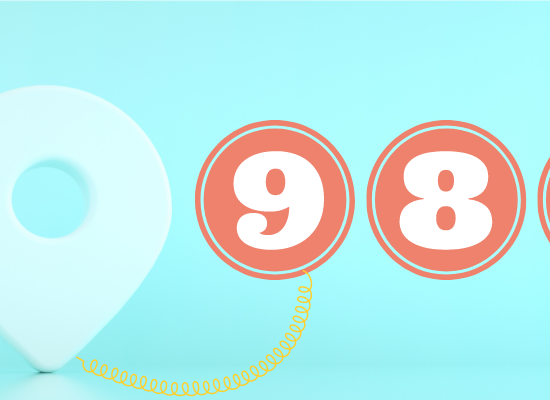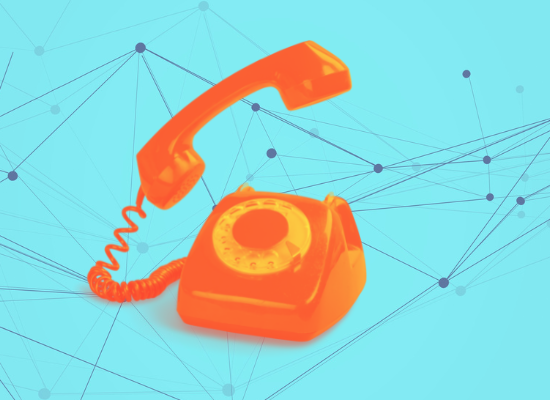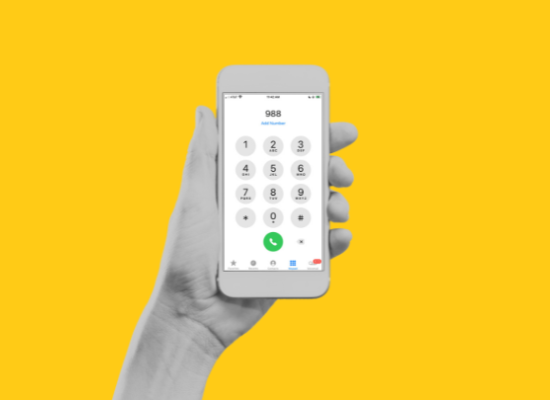
Annie Murdock sits at her computer monitoring multiple conversations at the Kansas Suicide Prevention Head Quarters (KSPHQ). She notices a particularly challenging and emotionally intense chat that a KSPHQ chat responder is engaged in. Immediately following this particular chat, Murdock hops on the phone with the crisis worker to provide support, debrief, and discuss self-care tips during and following their shift.
Murdock is the coordinator of KSPHQ’s Core Chat Program, overseeing 11 chat responders—paid positions staffed by primarily college students from the University of Kansas—who answer people’s outreach to the National Suicide Prevention Lifeline (Lifeline) Chat Program rather than by telephone (800-273-TALK).
KSPHQ is located in Lawrence, Kansas, and is one of over 30 Lifeline centers that offer chat services to answer Lifeline chats from all over the country. Starting with a successful pilot program with limited coverage in 2012, Lifeline chat services are currently available 24/7 across the U.S. through the Lifeline website.
While on the Lifeline Chat webpage, visitors fill out a quick pre-chat survey to provide basic demographic information and the issues they would like to discuss. This helps the crisis chat taker have some background when beginning the conversation and allows the Lifeline to collect baseline data on chat services.
In 2020, the Lifeline launched a universal chat platform that connects all chat centers to one queue to answer chat visitors. This has increased overall capacity and has made connecting chat visitors to chat responders more efficient and effective. In its pilot year nine years ago, the Lifeline handled 6,734 chats, and the number has steadily grown in each subsequent year. From July 2020 to July 2021, the Lifeline received over 586,000 chats.
According to Heather Kam, program manager of Clinical Technologies at Vibrant Emotional Health that oversees the Lifeline, chat services reach a younger demographic with higher acuity needs that might not otherwise access crisis services.
Kam notes that the pre-chat survey data shows that the majority of “chatters are under age 25, though this is self-reported.” According to that data, common concerns include suicide, family and relationships, support, and self-harm. Notably, approximately two-thirds of chatters answer “Yes—Current (within the last 24 hours)” to the question, “Do you have thoughts of suicide?”
“When we look at pre- and post-conversation answers from chatters on how distressed they are, we see consistent and significant de-escalation, and the vast majority of our chatters report that they found the service helpful,” reports Kam. These data emphasize the benefit of having chat services in ensuring young people with high acuity have their needs met in a way that’s accessible and relevant for them.
Training and Support for Chat Responders
At the beginning of 2014, when KSPHQ’s Core Chat Program became involved with the Lifeline Chat, crisis workers were only available between 11:00 pm and 3:00 am each day. However, KSPHQ has since expanded to 1 pm-9 pm seven days a week per their NSPL contract and can provide services at any time of the day or night. In addition, their program grew in 2019 from 5 to 11 chat responders with an additional supervisor position.
KSPHQ crisis chat takers receive 100+ hours of in-house training, including role-play and observation activities. They are also certified in the Lifeline sponsored evidence-based ASIST (Applied Suicide Intervention Skills Training) program. ASIST is a two-day, interactive workshop designed to help trainees recognize suicide risk factors, intervene to improve immediate safety, and link to community resources.
After completing this certification, KSPHQ’s training program, and valuable on-the-job experience of answering phone calls, certified crisis workers can start the training process to be chat responders.
To become a chat responder, KSPHQ utilizes training materials from the Lifeline to develop a several-week chat-specific training program, which they continue to refine over time. In order to support crisis workers with these challenging and often intense chats, they always have access to their supervisors in real-time during chats, monthly team meetings, one-on-one meetings to provide individualized feedback and support, self-care discussions, role-playing, ongoing training, including for specialized situations such as domestic violence chats, and other support systems.
The Flow of the Chat
It’s particularly important for chat responders to be appropriately trained and supported due to the often intense nature of these conversations. “Even before the pandemic, there was an observable difference between the intensity of chat versus phone services, and we’ve seen that increase over the last year and a half,” Murdock notes.
As mentioned above, chat visitors will fill out a pre-chat survey that gathers demographic information and the person’s primary concerns, including asking whether they are suicidal. Whether or not chatters express suicidality in the survey, chat crisis workers learn through conversations that most have had past or present suicidal thoughts.
Crisis chat takers use the chat-flow sequence, a flowchart with detailed instructions and questions, to conduct a risk assessment, actively listen to the chatter, and develop a collaborative safety plan. According to the Comprehensive Conversation Flow Document, developed by KSPHQ staff for the Core Chat program, chat conversations include these four parts in this order:
- Risk-assessment and lethal means reduction
- Listen, listen, listen
- Collaborative safety plan
- Conversation wrap-up
The responders aim to ask safety questions and complete the risk assessment as early as possible without breaking rapport with the chatter. Then they can gently carry the conversation to learn more about the chatter and how to help. The Conversation Flow Document aids in accounting for the unique challenges posed by chatting rather than speaking on the phone in gathering crucial information to keep the chatter safe and provide effective de-escalation and support.
“From my experience on both phone and chat, phone calls can be more organic because more information can be gathered in a short period of time,” Murdock shares. During chats, crisis workers need to direct the conversation without losing its flow. “Chatters will often share more information more quickly. They might open the conversation with the fact that they are having suicidal thoughts—this immediately ramps up the conversation’s intensity.”
Higher Acuity for Chatters
Even if the chatter doesn’t indicate suicidality, Murdock explains, “when you are communicating with someone over chat about their self-harm, it can increase chat crisis worker adrenaline and stress. Self-harm is very common but isn’t often suicidal. It’s used to release emotional pain. We remind them to stay calm and ask the right clarifying questions.”
According to KSPHQ, there has been an increase in reported self-harm in the past year related to the Covid pandemic, which contributes to high-stress moments during chats but emphasizes the importance of creating broad access to chat services to reach people in need of emotional support.
During the pandemic, social isolation has also increased, including for school-aged children as they spend more time in their homes and without support systems that might otherwise be in place.
“Since students might be at home with their families all day, and could get their phones taken away, a laptop that they have for school might be their only tool to connect to support. That’s one reason Lifeline chat is such an important method of crisis services to have available,” Murdock notes.
Dispatch to Chatters
Though the vast majority of people don’t require any in-person intervention, dispatch is also available for chatters if the crisis worker and their supervisor determine it’s necessary. As soon as the chat responder identifies that the chatter is at imminent risk, they contact their supervisor.
“One chatter was a young teen, home alone. Our crisis worker identified they had already taken some pills and reached out immediately to the supervisor on duty who contacted poison control as well as worked on getting emergency services out to the chatter; all the while, our crisis worker continued to engage with the chatter, ascertaining pertinent information from the chatter that would allow for us to get the chatter the help they needed,” Murdock shares.
This example demonstrates the integral role chat services play in providing life-saving interventions. As with any intense chat, following such a crisis, the chat responder and supervisor debrief to discuss their emotions and how to practice self-care.
KSPHQ contacts dispatch in the appropriate region if they’re able to locate the chatter via ISP address or the chatter provides their location. It can be challenging to locate the person as well as communicate with dispatch how they can assist in locating the person and how imminent the risk is in these cases. These challenges are particularly difficult in rural regions due to barriers like reduced broadband access and health services potentially located farther away from the chatter.
Though the need for mobile crisis intervention is rare, according to a recent CDC study, ER visits for a possible suicide attempt rose 50.6 percent for adolescent females aged 12 to 17 in the early months of 2021 compared to the corresponding period in 2019. KSPHQ doesn’t have data related to this study but anecdotally has noticed an increase in the acuity of chatters.
Due to the younger demographic of chat services, and the increase in adolescent stress over the past year, coupled with limited privacy at home, it’s unsurprising that suicide attempts have skyrocketed in this demographic. Lifeline chat services are an integral piece in reaching this population before an acute crisis or the worst possible outcome—death by suicide—and connecting them with services.
Chatting as a Bridge to Further Services and Support
Murdock described another special element of chat services: the bridge between different methods of communication to match the comfort of the person in need. Chatting can be more accessible since the person can express concerns through typing rather than speaking; this helps if privacy is a challenge or if it’s difficult for the person to voice the extent of their needs.
Another useful aspect of Lifeline chat is its anonymity. School-aged children can access these services in a crowded house and have privacy from their families. Those experiencing mental health crises due to domestic violence can connect to a chat responder without their abuser hearing. Names and voices aren’t exchanged, which can increase comfort levels for many in need, and they may be more open with the chat crisis worker as a result.
“We’ve found that some chatters will first disclose their suicidal thoughts to the crisis worker before bringing it up to their family, friends, or therapist,” Murdock describes.
The crisis chat taker is trained to provide follow-up resources and connections and remind the person that they can reach out again, either via chat or phone. It’s possible that by first sharing over chat, the person will feel more comfortable sharing over the phone in the future. Perhaps after a chat or phone call conversation, the person will feel more ready to share with family, friends, or a therapist.
Though they express that the chat services aren’t a therapy service, as part of KSPHQ’s crisis care services, chat responders do provide follow-up by email or phone for those who opt-in for follow-up and remind the chatter that they can reach out again and are available to help.
At the conclusion of the chat conversation, the crisis worker asks if they can share resources for local services to encourage the person to continue to reach out and seek support. “A positive, nonjudgmental experience with chat services can be a steppingstone for voice-to-voice or face-to-face support,” Murdock shares.
Chat Responder Workforce and Retention
Another important consideration in chat services, as with all crisis services, is the need for a robust workforce to meet demand. Though KSPHQ has expanded its staff since the program’s conception, there is still a greater need for crisis chat takers, particularly due to workforce shortages and increased chat volume exacerbated by the pandemic.
Murdock describes crisis chat work as “more draining and intense. A 4-hour shift can feel like an 8-hour shift.” As noted earlier, chatters are more prone to indicating suicidality earlier in the exchange than phone conversations, which can create a more demanding shift for the crisis worker.
With chat responders, who are often college students with their own stressors, they need support for their own mental health, which is a huge priority for Murdock and the chat supervisor, as the intensity of chats can weigh on crisis workers. “When you can hear someone’s voice on the phone, it’s easier to stay grounded,” Murdock explains.
To support chat crisis workers during their shifts, they are encouraged to take a minute to step away and unwind, and not to do more than they can handle. The support that Murdock and the Core Chat Program supervisor offer crisis chat takers reduces workforce burnout by ensuring they have the tools they need to take care of themselves and chat visitors.
Another challenge of being in a college town with a predominately college student workforce is its cyclical nature. “I hope to engage older community members to expand the workforce, offer different crisis worker perspectives, and provide more consistent availability,” Murdock comments.
As the nation turns to 988 starting July 16, 2022, it’s anticipated that the volume of chat services will increase along with other crisis services, which means an increased need for chat responders to meet the demand. Given the intense nature of the job, too many shifts each week for any one person can lead to burnout.
“The beauty of chat is that crisis workers can work from home, which has been particularly useful during the pandemic,” Murdock indicates. “I imagine a workforce where we have a larger pool of crisis workers by really engaging the community to provide support, then each crisis worker’s workload would be more manageable, and we could respond to more chats.”
Takeaways
It’s clear from Murdock’s anecdotes and experiences at KSPHQ that the invaluable benefit the Lifeline chat program provides is saving lives. Chat services often reach people who have higher acuity needs who might not otherwise reach out for support. Chat services are also accessed by many young people, which is a demographic that needs accessible and relevant crisis services due to the past 18 months of isolation and increased self-harm and suicidality among the population. The anonymity and ability for privacy in chat services make it a communication platform that’s integral for many in need of help to receive it. Crisis chat services also provide a bridge to further services and links to additional support services for chatters in need.








